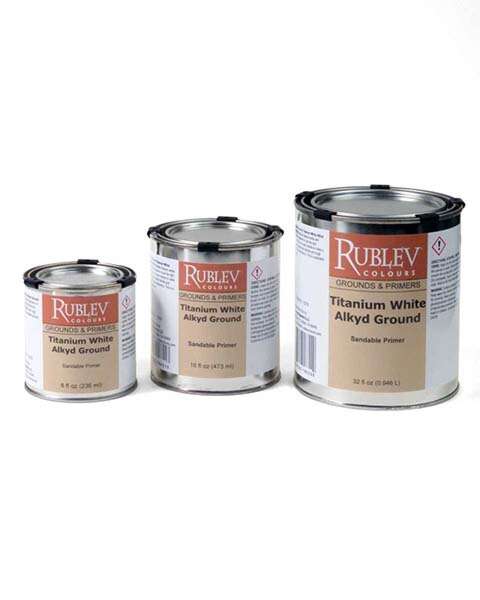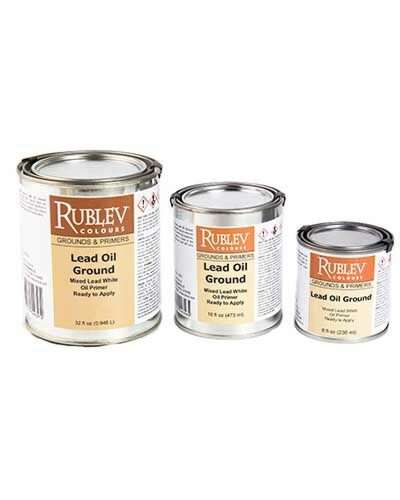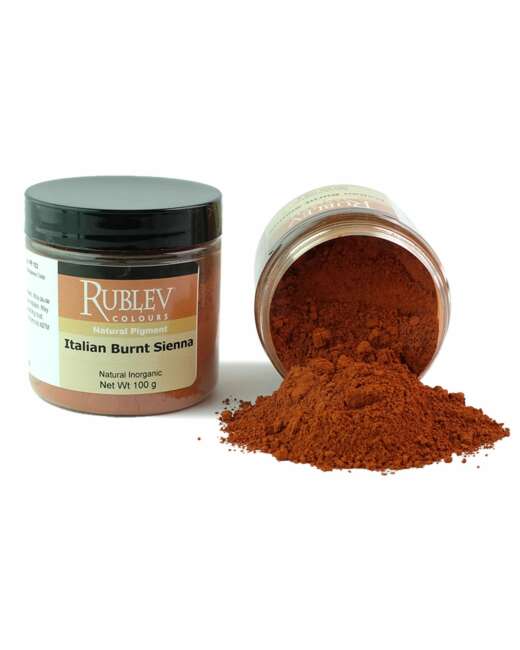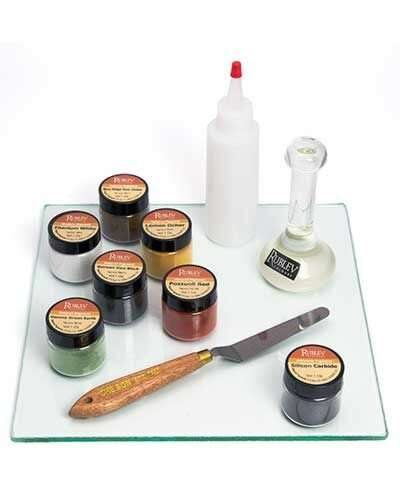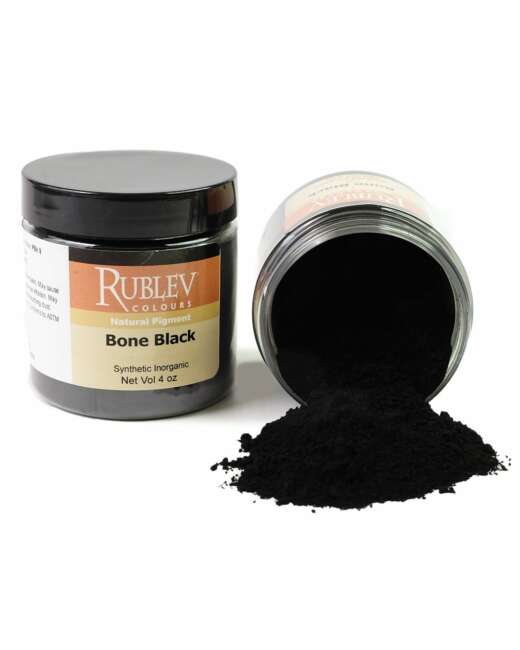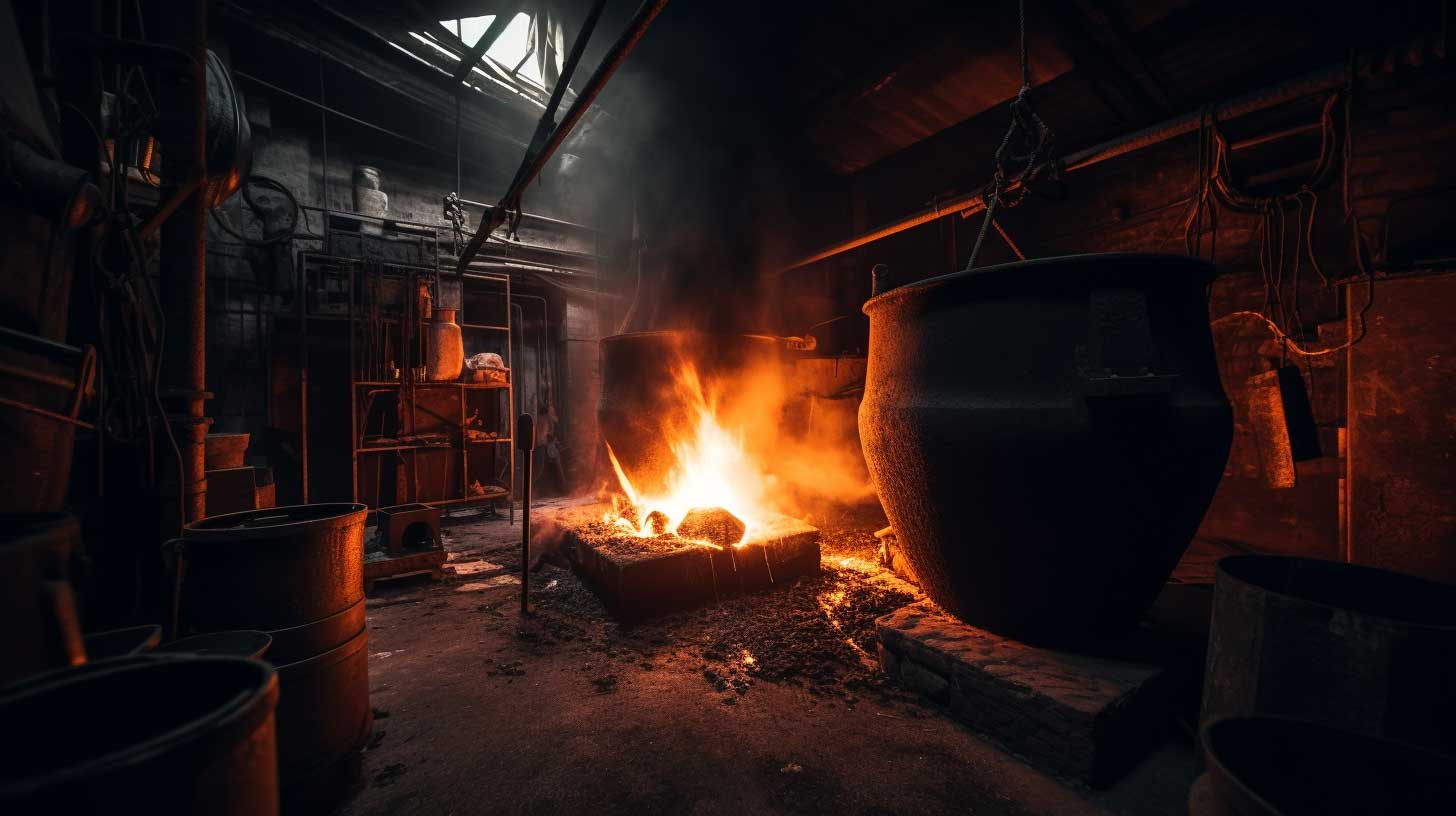
As a painter, the choice of pigment can greatly affect the outcome of your work. One particular pigment that has stood the test of time is Burnt Sienna. With its warm and earthy tones, Burnt Sienna has been a favorite among artists for centuries. In this article, we will explore everything you need to know about Burnt Sienna, including its history, properties, applications, and tips for using it in your oil paintings.
Table of Contents
- What is Burnt Sienna?
- History of Burnt Sienna
- Properties of Burnt Sienna
- Burnt Sienna in Oil Painting
- Mixing Burnt Sienna with Other Colors
- Techniques for Using Burnt Sienna
- Tips for Using Burnt Sienna
- Burnt Sienna vs. Raw Sienna
- Alternatives to Burnt Sienna
- How to Choose the Best Burnt Sienna Oil Paint
- Burnt Sienna in Artwork
- Conclusion
What is Burnt Sienna?
Sienna is an earth pigment that contains iron oxide and manganese oxide. It is known for its yellowish-brown color in its natural state, which is called burnt sienna. When heated, it transforms into a reddish-brown color called burnt sienna. The pigment derives its name from Siena, an Italian city-state, where it was extensively produced during the Renaissance period. Sienna, along with ochre and umber, is one of the oldest pigments used by humans, and it has been found in many ancient cave paintings. From the Renaissance onwards, it has been widely used as one of the most popular brown pigments by artists.
The first recorded use of the term sienna as a color name in English was in 1760, which was first used as a color name in English in 1924.
History of Burnt Sienna
Sienna is a natural pigment that has been used for centuries by artists around the world. The ancient Romans were aware of its properties and used it in its natural form. The pigment was originally mined near Arcidosso, which was once under Sienese control and is now located in the province of Grosseto, southern Tuscany. It was referred to as terra rossa, terra gialla, or terra di Siena.
During the Middle Ages, artists like Duccio di Buoninsegna and others who lived and worked in and around the Republic of Siena used sienna pigments. Duccio used earth pigments until his death in the early 14th century.
The Renaissance artist Giorgio Vasari noted the pigment under the name terra rossa. Sienna became one of the standard browns used by artists from the 16th to 19th centuries, including Caravaggio and Rembrandt, who used all three earth colors in their palettes. Cross sections of Rembrandt's works reveal that he used variations of sienna to prime his paintings, especially in his later works.
Although sienna and its variations were used by these artists, the pigment was not commonly referenced by name in European sources until the mid-eighteenth century. By the 1940s, the traditional Italian sources of the pigment were nearly exhausted. Today, much of the sienna production occurs in the Italian islands of Sardinia and Sicily, as well as in the Appalachian Mountains and the French Ardennes in the small town of Bonne Fontaine near Ecordal. It is important to note that the composition of sienna produced in France distinctly differs from the original siennas.
In the 20th century, synthetic iron oxide began to be used to produce pigments. The labels on paint tubes indicate whether they contain natural or synthetic ingredients. The Colour Index Generic Name (CIGN) Pigment Yellow (PY 23) indicates natural raw sienna, while Pigment Red 102 (PR 102) indicates natural burnt sienna. Aspiring artists should be aware of these distinctions and choose their materials accordingly to achieve the desired effects in their artwork. The Colour Index for natural burnt sienna can also be written as Pigment Brown 7 (PBr 7), as noted in Table 1 Suitable Pigment List of the ASTM D 4302 Standard Specification for Artists’ Oil, Resin-Oil, and Alkyd Paints.
Today, Burnt Sienna is still a popular color among artists due to its versatility and natural warmth.
Properties of Burnt Sienna
Sienna is a type of clay that is rich in iron oxide, similar to other earth colors such as yellow ochre and umber. The most common iron oxides found in sienna are limonite and goethite, which have yellowish hues in their natural states. Additionally, sienna contains manganese oxide, making it darker than ochre. Aluminum oxides have also been found in sienna at low levels. When heated, limonite and goethite are dehydrated and partially transformed into hematite, which gives sienna its reddish-brown hue. Burnt sienna is lighter than burnt umber, another clay pigment with iron oxide, because it has a higher content of manganese (5 to 20 percent), making it either greenish-brown or dark brown. When heated, raw umber becomes burnt umber, which is a much darker and warmer brown.
Burnt Sienna has a number of unique properties that make it a popular choice among oil painters. These properties include:
-
Warm, earthy tone: Burnt Sienna has a warm, natural color that is reminiscent of the Italian countryside.
-
High level of transparency: Burnt Sienna is highly transparent, which makes it ideal for glazing and layering.
-
Granular texture: Burnt Sienna has a granular texture that adds depth and dimension to paintings.
-
Low tinting strength: Burnt Sienna has a low tinting strength, which means it can be used to tone down brighter colors without overpowering them.
-
Lightfastness: Burnt Sienna has excellent lightfastness, which means it will not fade over time.
Burnt Sienna in Oil Painting
Burnt Sienna is a versatile pigment that can be used in a variety of ways in oil painting. It can be used as a base color for flesh tones, as a natural earth color, or as a glaze to add warmth and depth to paintings.
When used as a glaze, Burnt Sienna can create a warm, golden effect that is ideal for capturing the light of a Mediterranean landscape. It can also be used to create natural, earthy tones for landscapes, still lifes, and portraits.
Mixing Burnt Sienna with Other Colors
Burnt Sienna can be mixed with a wide range of colors to create unique shades and hues. When mixed with white, it creates a soft, reddish tint. When mixed with yellow ochers, it makes warm orange tints. Mixed with blues, it can create a range of warm browns and black. When mixed with reds, it can create deep, reddish-brown hues.

Burnt Sienna in mixtures with Lemon Ocher.

Burnt Sienna in mixtures with Ultramarine Blue and Titanium White

Comparison of Italian Burnt Sienna and French Burnt Sienna in mixtures with Lead White and Titanium White. The Italian Burnt Sienna is slightly warmer than the French Burnt Sienna.
Techniques for Using Burnt Sienna
Several techniques can be used when working with Burnt Sienna. These include:
-
Glazing: Burnt Sienna can be used as a glaze to create warm, golden effects. To do this, mix Burnt Sienna with a small amount of oil and apply it thinly over a dried layer of paint. This will create a warm, transparent layer that adds depth and dimension to your painting.
-
Dry brushing: Dry brushing is a technique where a dry brush is used to apply paint to the canvas, creating a textured effect. Burnt Sienna is a great color to use for dry brushing, as its granular texture can create interesting effects.
-
Washes: Burnt Sienna can also be used to create washes, which are thin, transparent layers of color. To create a wash, dilute Burnt Sienna with a small amount of solvent and apply it thinly to the canvas. This technique is great for creating soft, natural-looking backgrounds.
Tips for Using Burnt Sienna
Burnt Sienna is a versatile pigment that can be used for a wide range of applications. It is often used to create warm underpaintings or as a base color for skin tones. Burnt Sienna can also be used to create a range of colors when mixed with other pigments. When using Burnt Sienna in your paintings, there are a few tips to keep in mind:
- Because of its low tinting strength, it is important to use Burnt Sienna sparingly when mixing with other pigments.
- Burnt Sienna can be used to create a range of warm colors, but it is not ideal for creating cool or bright colors.
- In watercolor, Burnt Sienna has a slightly granulating texture, so it can be used to add texture and depth to your paintings.
-
Use it as a glaze: Burnt Sienna is a great color to use as a glaze, as it is transparent and adds warmth and depth to your paintings. Apply it thinly over a dried layer of paint to create a warm, transparent layer.
-
Mix it with other colors: Burnt Sienna can be mixed with a wide range of colors to create unique shades and hues. Experiment with different combinations to find the perfect color for your painting.
-
Use it for natural, earthy tones: Burnt Sienna is perfect for creating warm, earthy tones in landscapes, still lifes, and portraits. Use it as a base color for flesh tones or to create warm, natural backgrounds.
-
Experiment with techniques: There are several techniques you can use when working with Burnt Sienna, such as dry brushing and washes. Experiment with these techniques to create interesting effects in your paintings.
Burnt Sienna vs. Raw Sienna
Raw Sienna is natural earth pigment that is similar to Burnt Sienna but has not been processed to create a darker, rwarmer hue. Raw Sienna is a warm, yellow-brown color and is often used to create warm underpaintings or as a base for skin tones. While both pigments have similar properties, Burnt Sienna has a slightly darker and more intense hue, making it better suited for creating deeper shadows and richer colors.
Alternatives to Burnt Sienna
If you're looking for an alternative to Burnt Sienna, there are several options to choose from:
-
Red Ochre: Red Ochre is a natural earth pigment that has a similar warm, earthy tone to Burnt Sienna. It is a great alternative if you're looking for a more opaque color.
-
Burnt Umber: Burnt Umber is a natural earth pigment with a darker, cooler tone than Burnt Sienna. It is a great alternative if you're looking for a more neutral color.
-
Transparent Red Iron Oxide: Transparent Red Iron Oxide has many similarities in transparency and color to some Burnt Sienna pigments.
How to Choose the Best Burnt Sienna Oil Paint
When choosing a Burnt Sienna paint, there are a few things to consider:
-
Quality: Choosing high-quality paint that is made with pure, natural pigments is more difficult these days because paint manufacturers use Sienna to designate a color rather than the pigment. Look at the label for the Colour Index Pigment Red 102 (PY 43) or Pigment Brown 7 (PBr 7) to ensure you buy the natural pigment. Many manufacturers
-
Brand: Look for a reputable brand that is known for producing high-quality paints.
-
Consistency: Choose a paint that has a consistency that works for your painting style. Some artists prefer thicker paints, while others prefer thinner, more fluid paints.
Burnt Sienna in Artwork
Burnt Sienna has been used in many famous artworks throughout history. Here are a few examples:
Giorgio Vasari, The Battle of Marciano in Val di Chiana (Battaglia di Marciano in Val di Chiana), 1570–1571, Fresco, 1300 x 760 cm, Comune di Firenze: Giorgio Vasari (1511–1574) used earth colors, including ochre and sienna, in his frescos, such this in the Hall of the Five Hundred at the Palazzo Vecchio in Florence. In his writings, Vasari referred to sienna as terra rossa.

Rembrandt van Rijn, Self-Portrait with Circles, c. 1665–1669, Oil on canvas, 114.3 cm × 94 cm (45.0 in × 37 in), Kenwood House, London: Rembrandt used all the earth pigments (sienna, ochre, and umber) to create his rich and complex browns.

Rembrandt van Rijn, Portrait of Margaretha de Geer, Wife of Jacob Trip, c.1661, Oil on canvas, 130.5 × 97.5 cm, National Gallery, NG1675: Rembrandt used yellow, red, and brown earth colors mixed with black and lead white in the underpainting of the lighter areas of the background of this portrait.

Helen Allingham RWS (1848–1926) was a British watercolorist and illustrator of the Victorian era. This is a reproduction of a watercolor, The Old Inn, from The Practice of Water-Colour Painting. The colors she generally uses in her watercolors are cobalt blue, cerulean, permanent yellow, aureolin, cadmium orange, yellow ochre, raw sienna, burnt sienna, rose madder, light red, and sepia.

Robert Weir Allan (1851–1942) was a Scottish-born painter known mainly for his depiction of landscape and marine subjects. Arriving From the Ferry is a watercolor with a view of Dordrecht (Holland), 1888. He often did many studies for oil paintings in watercolor. The following is a description from The Practice of Water-Colour Painting of his use of color.
As a rule Mr. Allan does not resort to any devices like sponging or washing down to give softness to his work, but if a correction or alteration has to be made he does not hesitate to wash out the part of the painting that fails to satisfy him, and to fill the gap again with direct and definitely drawn touches. The point that he insists upon is that there should be no fumbling or uncertainty in the manner of applying the pigments. If changes are necessary they must first be carefully considered, and then carried out with just as much confidence as if they had formed part of the scheme from the first; to hesitate over them would be to destroy the conviction of the work all through. For very small alterations, he might occasionally use body-colour, otherwise he always paints transparently.
The colours Mr. Allan uses are yellow ochre, permanent yellow, lemon yellow, cobalt, indigo, raw sienna, burnt sienna, light red, extract of vermilion, rose madder, brown madder, Vandyke brown, raw umber, and black.
Conclusion
Burnt Sienna is a versatile and timeless pigment that has been a favorite among artists for centuries. Its warm and earthy tones make it ideal for creating a range of colors, from warm underpaintings to rich shadows. When using Burnt Sienna in your oil paintings, it is important to remember its low tinting strength and slightly granulating texture. By following these tips and experimenting with different mixtures, you can use Burnt Sienna to create unique and beautiful works of art.
Frequently Asked Questions
Is Burnt Sienna a toxic pigment?
Burnt Sienna is a non-toxic pigment that is safe to use in art.
Is Burnt Sienna a natural pigment?
Burnt Sienna is a natural earth pigment that is derived from various earth composed of the mineral hematite and contains accessory minerals such as clay, chalk, or silica.
Where is Burnt Sienna sourced from?
Burnt Sienna is sourced from various deposits around the world, including Italy, France, Cyprus, the United States, and Russia.
How is Burnt Sienna processed?
Burnt Sienna is extracted from the earth in open quarries and then washed to remove impurities and refine the color. It is then heated in furnaces to produce a reddish-brown hue.
What is the difference between Raw Sienna and Burnt Sienna?
Raw Sienna is a lighter, more yellow-brown version of Sienna, while Burnt Sienna is a darker, reddish-brown version. Burnt Sienna is made by heating Raw Sienna, which alters its colors to a reddish-brown.
Can I use Burnt Sienna for glazing?
Burnt Sienna is a good choice for use in glazes because it is a transparent pigment. Mix Burnt Sienna with a small amount of oil and apply it thinly over a dried layer of paint to create a warm, transparent layer.
Is Burnt Sienna lightfast?
Yes, Raw Sienna has excellent lightfastness and will not fade over time.
Can Burnt Sienna be used in other mediums besides oil paint?
Yes, Burnt Sienna is also available in watercolor, gouache, and acrylic paint, as well as other art mediums.
Can I use Burnt Sienna in a limited color palette?
Burnt Sienna is a great addition to a limited color palette and can be used to create a wide range of natural warm tones and hues.
How can I make Burnt Sienna darker?
You can make Burnt Sienna darker by mixing it with a small amount of Ultramarine Blue or Burnt Umber.
Can Burnt Sienna be used for watercolor painting?
Burnt Sienna can be used for watercolor painting, but it will have different properties when used with this medium than in oil paint.
References
Webster’s New World Dictionary of the American Language. College Edition. 1964.
Maerz, Aloys John., Paul, Morris Rea. (1930). A Dictionary of Color. United States: McGraw-Hill Book Company, Inc. p. 204; Color Sample of Sienna: p. 37 Plate 7 Color Sample E12
Helwig, Kate (2007). “Iron Oxides.” Artists’ Pigments. Vol. 4. Archetype Publications. ISBN 978-1-904982-234.
Wilcox, Michael (2002). Blue and yellow don’t make green. School of Color. pp. 172, 161. ISBN 0-9679628-7-0. Retrieved October 19, 2009.
Roelofs, Isabelle (2012). La couleur expliquée aux artistes. Groupe Eyrolles. p. 30. ISBN 978-2-212-134865.
Manasse, Andrea; Mellini, Marcello (2006). “Iron (hydr)oxide nanocrystals in raw and burnt sienna pigments.” European Journal of Mineralogy: 845. doi:10.1127/0935-1221/2006/0018-0845.
Burnet, John. A Treatise on Painting, in Four Parts: Consisting of an Essay on the Education of the Eye with Reference to Painting, and Practical Hints on Composition, Chiaroscuro, and Colour ; the Whole Illustrated by Examples from the Italian, Venetian, Flemish and Dutch Schools. United Kingdom: J. & J. Leighton, 1850. p. 4.
Bomfeld, David; Brown, Christopher; Roy, Ashok. (1988) Rembrandt—Art in the Making. Yale University Press. ISBN 978-0-300-06145-1.
Plesters, Joyce (1956). “Cross-Sections and Chemical Analysis of Paint Samples.” Studies in Conservation. 2 (3): 122–125. doi:10.2307/1505000.
Vasari, Giorgio. Lives of the Most Eminent Painters, Sculptors, and Architects.
Helwig, Kate. (1997). “A Note on Burnt Yellow Earth Pigments: Documentary Sources and Scientific Analysis.” Studies in Conservation. 42 (3): 181–188. doi:10.2307/1506714. ISSN 0039-3630.
Baldry, Alfred Lys. The Practice of Water-colour Painting, Illustrated by the Work of Modern Artists. United Kingdom: Macmillan and Company, limited, 1911.
Color Notes: Burnt Sienna
Burnt Sienna Pigments
Luberon Burnt Sienna Pigment
| Pigment Names | |||
| Common Names: | English: burnt sienna French: terre de sienne brûlée German: Gebrannte Sienaerde Italian: terra di siena bruciata Russian: сиена жженая Spanish: tierra de siena tostada |
||
| Nomenclature: |
|
||
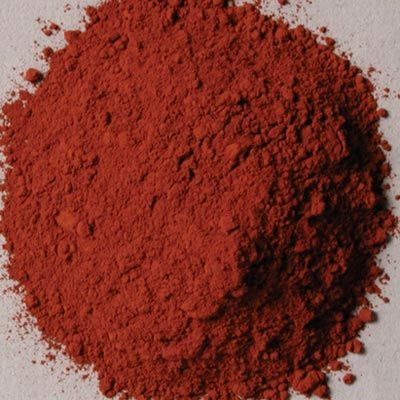
Rublev Colours Pigment: Luberon Burnt Sienna
| Pigment Information | |
| Color: | Brown |
| Colour Index: | Pigment Red 102 (77491) |
| Chemical Name: | Iron Oxide |
| Chemical Name: | Fe2O3 |
| ASTM Lightfastness Rating | |
| Acrylic: | I |
| Oil: | I |
| Watercolor: | I |
| Properties | |
| Density: | 3.3–4.3 |
| Hardness: | 5.0–5.5 |
| Refractive Index: | nα=2.260 nβ=2.393 nγ=2.398 |
Italian Burnt Sienna Pigment
| Pigment Names | |||
| Common Names: | English: burnt sienna French: terre de sienne brûlée German: Gebrannte Sienaerde Italian: terra di siena bruciata Russian: сиена жженая Spanish: tierra de siena tostada |
||
| Nomenclature: |
|
||
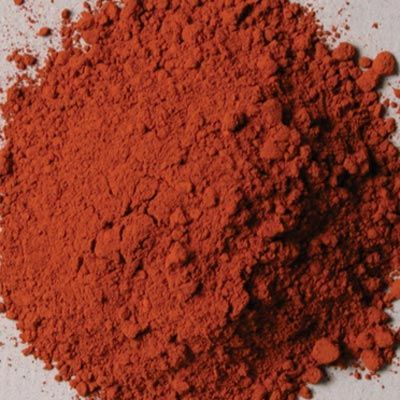
Rublev Colours Pigment: Italian Burnt Sienna
| Pigment Information | |
| Color: | Brown |
| Colour Index: | Pigment Red 102 (77491) |
| Chemical Name: | Iron Oxide |
| Chemical Name: | Fe2O3 |
| ASTM Lightfastness Rating | |
| Acrylic: | I |
| Oil: | I |
| Watercolor: | I |
| Properties | |
| Density: | 3.3–4.3 |
| Hardness: | 5.0–5.5 |
| Refractive Index: | nα=2.260 nβ=2.393 nγ=2.398 |
Burnt Sienna Oil Paint
French Burnt Umber Oil Paint
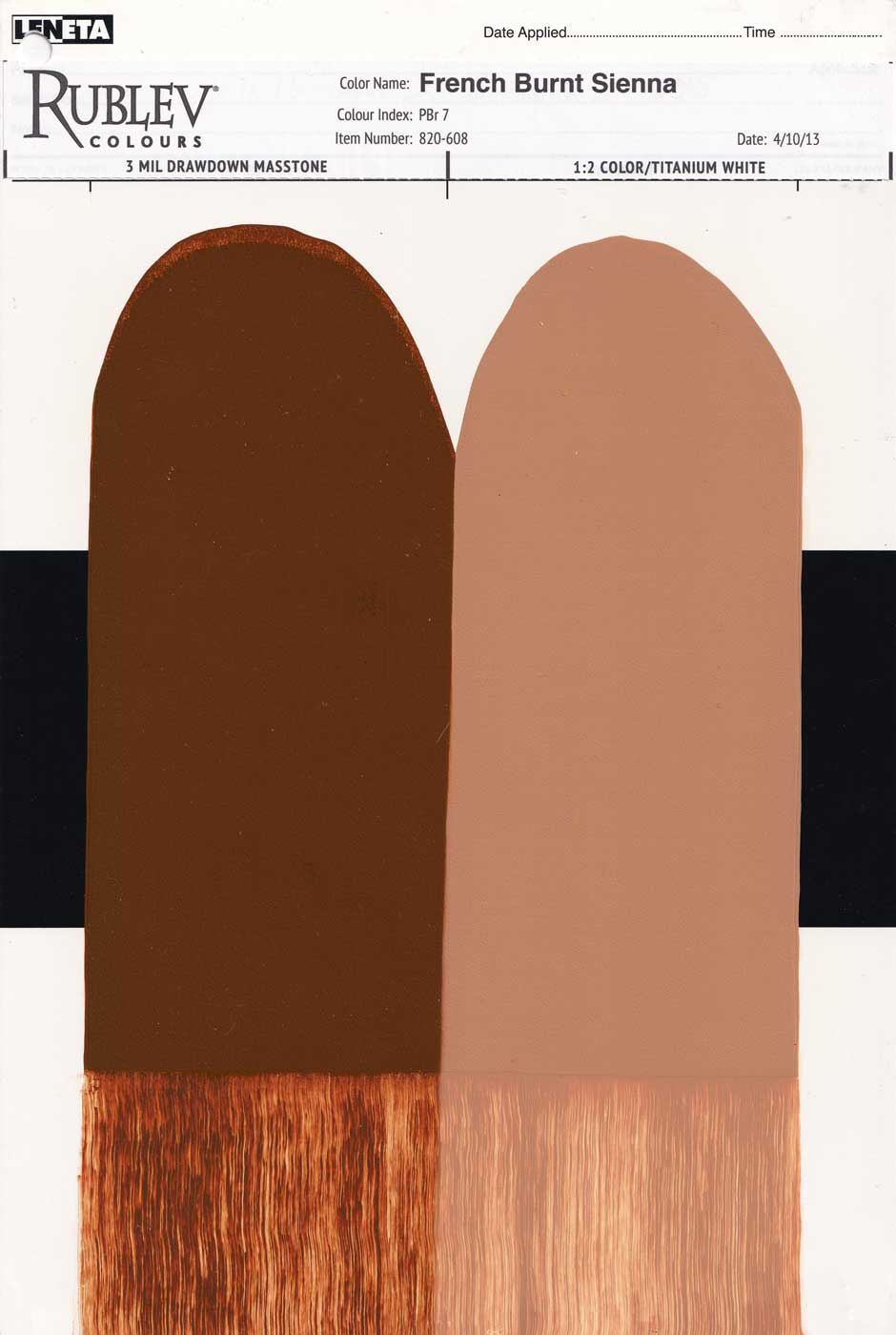

French Burnt Sienna Oil Paint
| French Burnt Sienna | |
| Color: | Brown |
| Binder: | Linseed oil |
| Additive(s): | None |
| Pigment Information | |
| Pigment: | Burnt Sienna |
| Pigment Classification: | Natural inorganic |
| Colour Index: | Pigment Red 102 (77491) |
| Chemical Name: | Iron oxide |
| Chemical Formula: | Fe2O3 |
| CAS No. | |
| Properties | |
| Code: | 608 |
| Series: | 1 |
| Opacity: | Semi-Transparent |
| Tinting Strength: | Medium |
| Drying Rate: | Medium |
| ASTM Lightfastness: | I |
| Permanence: | A |
| Safety Information: | No acute or known chronic health hazards are associated with this product's anticipated use (most chemicals are not thoroughly tested for chronic toxicity). Protect yourself against potentially unknown chronic hazards of this and other chemical products by keeping them out of your body. Do this by avoiding ingestion, excessive skin contact, and inhaling spraying mists, sanding dust, and vapors from heating. Conforms to ASTM D-4236 |
For a detailed explanation of the terms in the table above, please visit Composition and Permanence.
Italian Burnt Sienna Oil Paint
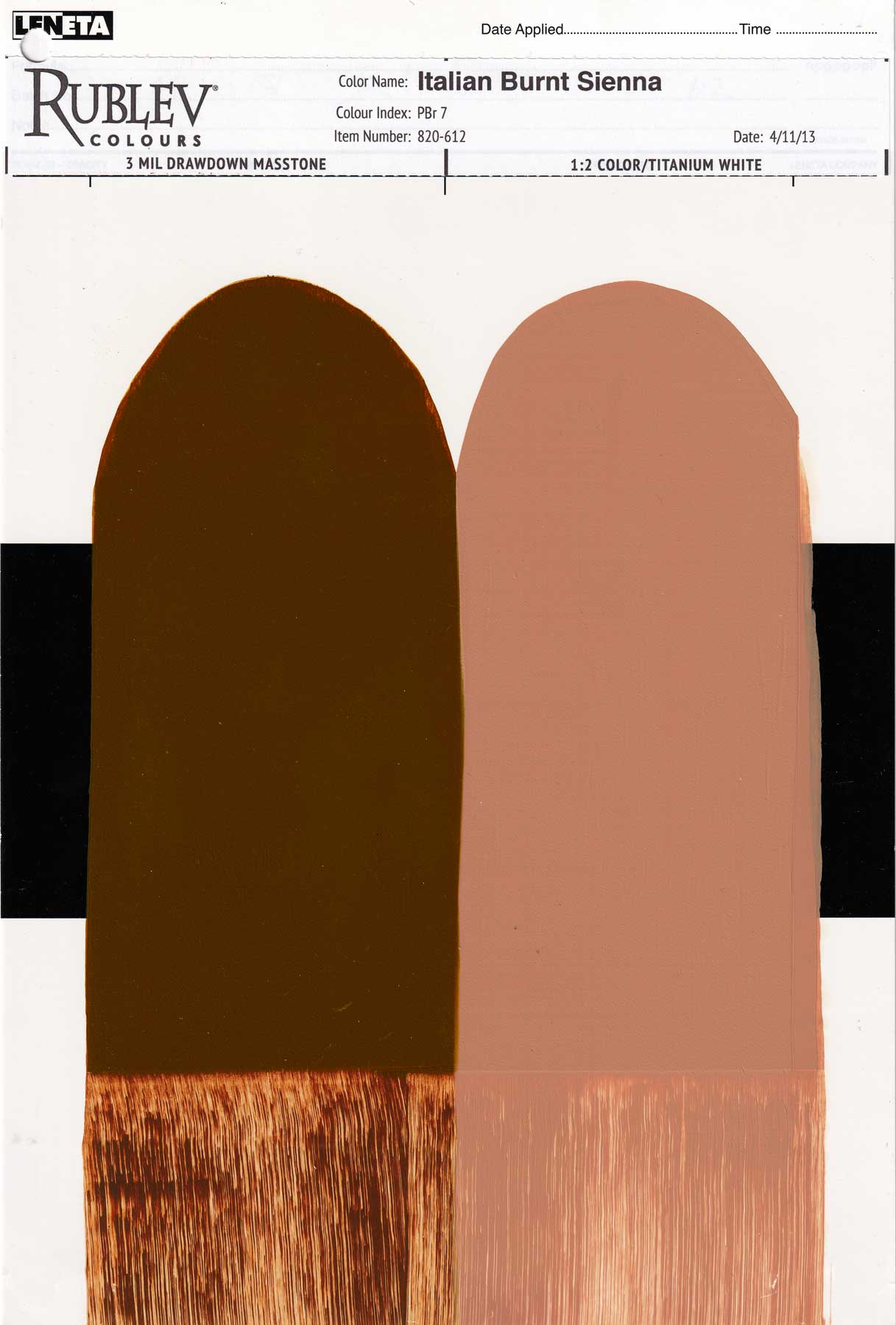

Italian Burnt Sienna Oil Paint
| Italian Burnt Sienna | |
| Color: | Brown |
| Binder: | Linseed oil |
| Additive(s): | None |
| Pigment Information | |
| Pigment: | Burnt Sienna |
| Pigment Classification: | Natural inorganic |
| Colour Index: | Pigment Red 102 (77491) |
| Chemical Name: | Iron oxide |
| Chemical Formula: | Fe2O3 |
| CAS No. | |
| Properties | |
| Code: | 903 |
| Series: | 1 |
| Opacity: | Opaque |
| Tinting Strength: | High |
| Drying Rate: | Medium |
| ASTM Lightfastness: | I |
| Permanence: | A |
| Safety Information: | No acute or known chronic health hazards are associated with this product's anticipated use (most chemicals are not thoroughly tested for chronic toxicity). Protect yourself against potentially unknown chronic hazards of this and other chemical products by keeping them out of your body. Do this by avoiding ingestion, excessive skin contact, and inhaling spraying mists, sanding dust, and vapors from heating. Conforms to ASTM D-4236 |
For a detailed explanation of the terms in the table above, please visit Composition and Permanence.



